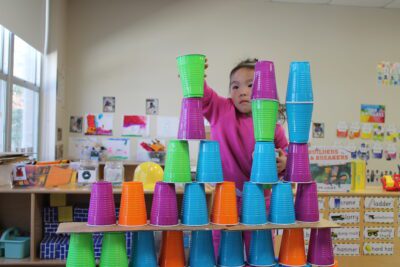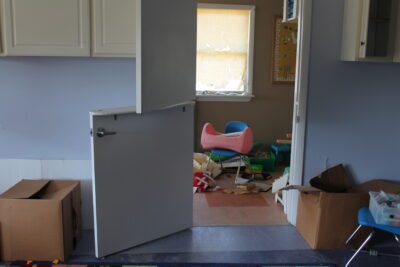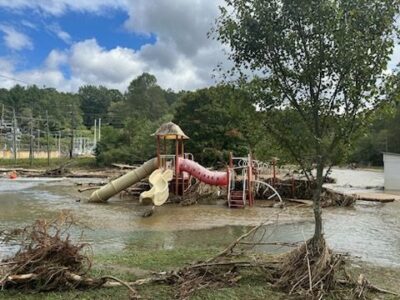The number of licensed family child care homes (FCCHs) in North Carolina has decreased by 22% since before the pandemic.
During the five years when pandemic-era funding was used to stabilize the state’s licensed child care programs, the number of licensed FCCHs decreased by 19%. Since the funding ran out at the end of March, they’ve decreased by 3% — the largest single-quarter decline in the two years since EdNC began tracking these changes.
There are efforts around the state the reverse this trend.
In a Charlotte banquet hall on a recent Saturday night, leaders in ballgowns and tuxedos gathered together to celebrate a group of entrepreneurs who had completed a leadership program specifically for home-based providers.
With funding from the Blue Cross and Blue Shield of North Carolina Foundation, MDC’s Home-Based Child Care Haven (HBCC Haven) program paid monthly stipends to the 10 members of the inaugural cohort — women who operate FCCHs and those who run license-exempt family, friend, and neighbor (FFN) care in their communities across North Carolina.
The cohort participated in leadership training, mentorship, and advocacy skill-building with the goal of empowering them to advance change in the state’s child care systems. They completed their training at a crucial moment for home-based care in North Carolina.

Diverging numbers for licensed centers and homes
Based on data provided by the N.C. Child Care Resource and Referral (CCR&R) Council in partnership with the state Division of Child Development and Early Education (DCDEE), EdNC previously found that North Carolina lost less than 6% of licensed child care programs, which include both centers and FCCHs, during the five years when stabilization grants were used to supplement teacher wages.
That remains true since the end of stabilization grants, but data on licensed child care through the end of June 2025 shows that FCCHs now make up all of those net losses because the number of licensed child centers has returned to — and slightly surpassed — pre-pandemic levels.
There were 3,879 licensed child care centers in February 2020 and 3,886 in June 2025 — a net gain of seven sites. During that same period, the number of licensed FCCHs dropped from 1,363 to 1,061 — a net loss of 302 sites.
And from April to June 2025, the first quarter since the end of stabilization grants, North Carolina had a net gain of 44 licensed child care centers. FCCHs saw a net loss of 35 FCCHs in that timeframe.
Despite the net gain in the number of licensed child care centers, enrollment has decreased by 2% since before the pandemic. For licensed FCHHs, that decline is 23%. The overall population of children age five and under has increased in North Carolina over the last five years.
As EdNC works in coming months to understand both the recent increase in the number of licensed child care centers and the decrease in overall enrollment, please reach out to Katie Dukes with any insights you might have.
While we don’t yet know why the number of licensed centers is increasing, Courtney Alexander, a program director for MDC, has a strong sense of why licensed FCCHs are decreasing.
“Many of the family child care home providers do not have retirement (funds), and they do not have (health care) benefits, and many of them are already over 40 or over 50,” Alexander said.
Alexander said some of her own colleagues are former home-based providers who gave up their licenses to take other forms of early childhood work that would provide access to health care and retirement benefits.
“If the state was able to offer benefits to every early care and education teacher like they offer to the public school teachers, that would be a great infusion of support,” Alexander said.
And as home-based providers leave the early care and learning workforce, Alexander said there’s little incentive for new educators to fill those gaps due in part to low wages and lack of benefits — a problem faced by centers as well.
Role of home-based early care and learning
While a greater number of North Carolina’s youngest learners are enrolled in licensed centers than in licensed FCCHs, home-based care plays an essential role in the state’s early care and learning landscape.
“Why it matters is the net loss of those spaces is very important to a family’s ability to be able to find care,” Alexander said.
Alexander and Theresa Stacker, executive director of NC Early Childhood Foundation, identified a wide variety of reasons that families choose home-based care.
In rural areas with less population density, home-based care is more practical than centers. Home-based care can also be the best cultural match for families, especially when it comes to language development. Home-based providers can provide more one-on-one learning opportunities, which is especially beneficial to identifying and supporting students with learning differences.
Both Alexander and Stacker noted that home-based providers have more flexible hours, which can benefit factory and health care workers, as well as first responders and some military personnel.
Related reading

Child care programs consider closing following the end of stabilization grants
by Katie Dukes |

‘We have to have action’ to halt, reverse net loss of licensed child care programs
by Katie Dukes |

Western NC child care programs, ‘already in a fragile state,’ hit by Helene
by Liz Bell and Katie Dukes |
“Family child care homes have been, by far, the leaders of having different available shifts for families,” Stacker said.
“Where would families who work second and third shift find care if they only had centers to rely on?” Alexander said.
Home-based early care and learning also plays an important role in providing infant care.
Alexander noted that parents tend to prefer home-based programs over center-based programs when it comes to infants.
She said new parents especially are more likely to want their infants to be with people from their community who they already know and trust, and who will develop a personal relationship with their child.
In licensed care, FCCHs enroll a higher proportion of infants than centers. In February 2020, 9% of students enrolled in FCCHs were infants, compared to 6% of students enrolled at centers.
The net loss of licensed FCCHs is affecting the availability of infant care. By June 2025, infant enrollment at centers had dropped one percentage point — but it had dropped three percentage points at FCCHs.
For both Alexander and Stacker, the decrease in licensed FCCHs represents a decrease in families having the freedom to choose the best early care and learning fit for their children.
“The families choose these women because they trust them and because they don’t want to worry about their children while they’re trying to work,” Alexander said.
“When you lose family child care homes, you’re losing an important piece of that child care fabric,” Stacker said.

Subgroup trends
In addition to monitoring overall licensed child care trends, there are three subgroups of counties that EdNC has been following since we started tracking quarterly net gains and losses in licensed child care.
Here’s the latest on the western counties that make up the area covered by the Dogwood Health Trust, majority-Black counties, and counties with large Indigenous populations.
In the Dogwood counties (Avery, Buncombe, Burke, Cherokee, Clay, Graham, Haywood, Henderson, Jackson, Macon, Madison, McDowell, Mitchell, Polk, Rutherford, Swain, Transylvania, and Yancey), the number of licensed child care sites is 3% lower than before the pandemic.
In the majority-Black counties (Bertie, Edgecombe, Halifax, Hertford, Northampton, Vance, Warren, and Washington), the number of licensed child care sites remained relatively stable during and after the pandemic, with the same number of licensed child care sites in June 2025 as February 2020.
And in Robeson and Swain, which both have large Indigenous populations, the number of licensed child care sites has also remained relatively stable. It’s worth noting that while the number of licensed sites in Robeson is still slightly higher than before the pandemic, it’s been decreasing since fall 2024.
Editor’s note: The Blue Cross and Blue Shield of North Carolina Foundation and the Dogwood Health Trust support the work of EducationNC.
This article first appeared on EdNC and is republished here under a Creative Commons Attribution-NoDerivatives 4.0 International License.

